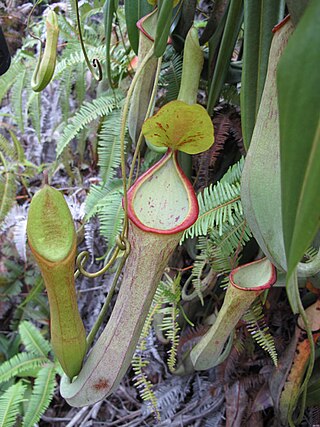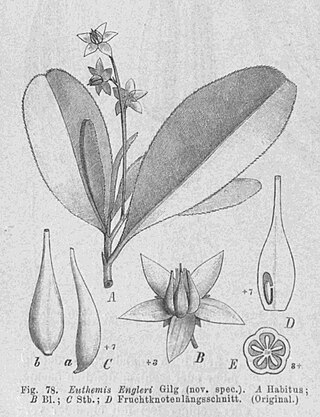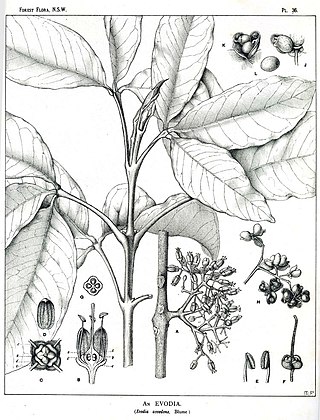
Nepenthes macrovulgaris, or the serpentine pitcher-plant, is a tropical pitcher plant endemic to Borneo. It is a lowland plant that typically grows at altitudes ranging from 300 to 1200 m in sub-montane forest clearings and mossy forest. Its range is restricted to ultramafic habitats, including Mount Kinabalu, Mount Tambuyukon, the Danum Valley, the Tawai Range, the Meliau Range and Mount Silam, all in Sabah, Malaysian Borneo. Pitchers grow to around 25 cm high and range in colour from green to brown, with the speckled form being the most common.

Nepenthes campanulata, the bell-shaped pitcher-plant, is a tropical pitcher plant native to Borneo. It has also been reported from Palawan, the Philippines, though further field work is needed to confirm this identification.

The Mantanani scops owl, is a small owl in the scops-owl genus Otus found on small islands between Borneo and the Philippines. It is listed by the IUCN as "near threatened" because its range is limited with its population being fragmented on several different islands, and its forest habitat is being degraded by ongoing logging and clearance.

The Rajah spiny rat also known as the brown spiny rat is endemic to Thailand and Malaysia, Sumatra, Borneo, and adjacent islands.

Cratoxylum arborescens is a plant in the family Hypericaceae. The specific epithet arborescens is from the Latin meaning "tree-like".

Adonidia is a genus of flowering plants in the family Arecaceae, native to the Philippines and Borneo.

Pelophryne misera, the black flathead toad or Kinabalu dwarf toad, is a species of toad in the family Bufonidae. It is endemic to northwestern Borneo and known from Sabah and Sarawak (Malaysia), although its distribution is likely to be broader and might extend to Kalimantan (Indonesia). It was first described from specimens collected from Mount Kinabalu.
Brackenridgea palustris is a tree in the family Ochnaceae. The specific epithet palustris is from the Latin meaning "swampy", referring to the species' habitat.

Euthemis minor is a plant in the family Ochnaceae. The specific epithet minor is from the Latin meaning "small", referring to the species' smaller size when compared with E. leucocarpa.
Glyptopetalum palawanense is a tree in the family Celastraceae. The specific epithet palawanense refers to the species being native to the island of Palawan in the Philippines.
Kibara coriacea is a plant in the family Monimiaceae. The specific epithet coriacea is from the Latin meaning "leathery", referring to the leaves.

Vatica rassak is a tree in the family Dipterocarpaceae, native to Maritime Southeast Asia. The specific epithet rassak is from resak, the species' Malay common name.
Barringtonia reticulata is a plant in the family Lecythidaceae. The specific epithet reticulata means "like a network", referring to the leaf veins.
Madhuca elmeri is a plant in the family Sapotaceae. It is named for the American botanist and plant collector Adolph Elmer who worked extensively in the Philippines and Borneo.
Palaquium quercifolium is a tree in the family Sapotaceae. The specific epithet quercifolium refers to the leaves' similarity to the genus Quercus.
Diospyros coriacea is a tree in the family Ebenaceae. The specific epithet coriacea means "leathery", referring to the leaves. The species is native to Peninsular Malaysia, Singapore and Borneo.
Glyptopetalum quadrangulare is a plant in the family Celastraceae. The specific epithet quadrangulare means "four-angled", referring to the winged twigs.

Melicope accedens is a plant in the family Rutaceae.
Symplocos celastrifolia is a plant in the family Symplocaceae, native to Southeast Asia. The specific epithet celastrifolia refers to the leaves' resemblance to those of species in the genus Celastrus.
Quercus gaharuensis is a species of oak native to Borneo, Sumatra, and Peninsular Malaysia. It is placed in Quercus subgenus Cerris, section Cyclobalanopsis.










